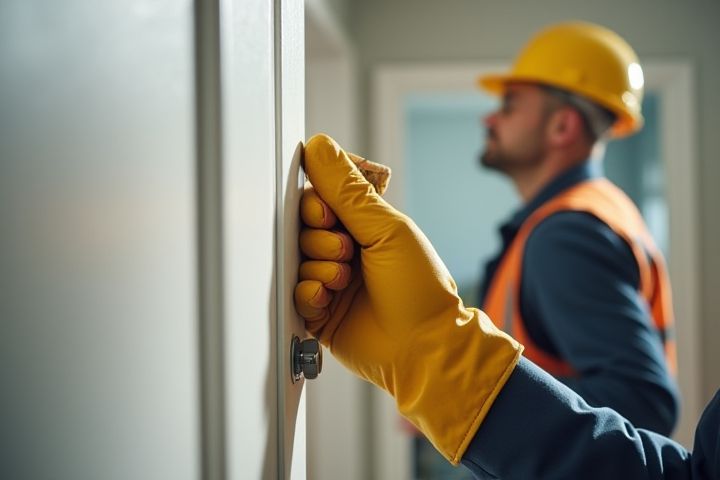
During a house inspection, you should first ensure that you are present to observe the process, as this allows you to ask questions and gain insights into the property's condition. Inspectors typically evaluate critical systems such as plumbing, electrical, HVAC, and the roof, providing a comprehensive overview of maintenance issues. Make sure to review the inspector's findings in real-time, noting any immediate concerns or potential safety hazards. After the inspection report is delivered, take time to assess how the identified issues may influence your decision regarding the home purchase or negotiation for repairs. Understanding this data will empower you to make informed choices about your investment in the property.
What To Do During A House Inspection
Examine structural integrity
During a house inspection, thoroughly examine the structural integrity of critical components like the foundation, walls, and roof. Look for signs of cracks, settling, or water damage, as these issues can indicate serious problems. Pay attention to load-bearing elements and ensure they are properly supported and free from defects. Each year, approximately 7% of homes face structural issues, making your careful observation essential for informed decision-making.
Check for water damage
During a house inspection, it's essential to thoroughly check for signs of water damage, as this can indicate underlying issues. Inspect areas around windows, doors, and roofs for any discoloration, warping, or mold growth, which may signal leaks. Pay close attention to the basement and foundation, where water intrusion can lead to significant structural damage over time. You should also examine plumbing fixtures and water pipes for corrosion or leaks, ensuring that the home is not hiding costly repairs in its walls.
Inspect electrical systems
During a house inspection, focusing on the electrical systems is crucial for ensuring safety and functionality. Check the electrical panel for proper labeling, functioning circuit breakers, and any signs of rust or corrosion, which can indicate underlying issues. Observe the outlets for proper grounding and test their functionality with a receptacle tester, ensuring they meet safety standards. Furthermore, inspect visible wiring for frayed insulation or improper installations, and confirm that any major appliances are adequately connected without overloading the system.
Test plumbing fixtures
During a house inspection, it's crucial to test all plumbing fixtures to ensure they're functioning correctly. You should run all faucets for at least 3 minutes each to check for water pressure and hot water availability. Inspect toilets for leaks by adding food coloring to the tank and observing if it seeps into the bowl within 30 minutes. Don't forget to test showerheads, tubs, and any outdoor spigots, noting any signs of corrosion or water stains that might indicate underlying issues.
Investigate heating and cooling systems
During a house inspection, thoroughly investigate the heating and cooling systems, as they significantly impact your home's energy efficiency and comfort. Check the age of the HVAC system; systems over 15 years old may require costly repairs or replacements. Ensure that the filters are clean and inspect ductwork for debris, as dirty ducts can hinder performance and air quality. You should also inquire about the maintenance history, as regular servicing can prevent unexpected breakdowns and extend the system's lifespan.
Assess roof condition
During a house inspection, assessing the roof condition is crucial for understanding the home's overall integrity. Look for signs of wear such as missing shingles, discoloration, or curling edges, which can indicate potential leaks or structural issues. Inspect gutters and downspouts for proper functionality, as clogged systems can lead to water damage. You may also want to check the attic for moisture buildup or signs of pests, which can further impact the roof's health.
Inspect insulation and ventilation
During a house inspection, focusing on insulation and ventilation is crucial for energy efficiency and comfort. Check for proper insulation levels in attics, walls, and crawl spaces, which typically should be at least R-30 in attics to prevent heat loss. Inspect ventilation systems to ensure they are adequate; for example, each bathroom should have a dedicated exhaust fan, while attics require venting to improve air circulation and prevent moisture buildup, ideally 1 square foot of ventilation for every 300 square feet of attic space. Adequate insulation and ventilation not only promote a healthy environment but can also significantly lower your energy bills, making them essential areas to examine.
Check for pest infestations
During a house inspection, prioritize checking for pest infestations, as they can significantly impact your home's integrity and value. Look for signs of rodents or insects, such as droppings, gnaw marks, or hollow sounds in walls. Pay attention to areas like basements, attics, and crawl spaces, where pests commonly reside. Engaging a professional pest inspector can provide an in-depth analysis, ensuring your future home remains pest-free and secure.
Test smoke and carbon monoxide detectors
During a house inspection, ensure that the smoke and carbon monoxide detectors are functioning properly. Test each device by pressing the test button and confirming that it emits an audible alarm; do this for all detectors in your home, including those near sleeping areas. Check the expiration dates on your detectors, as most have a lifespan of about 10 years and may need replacement. You can also consider replacing the batteries at least once a year to ensure they remain operational, enhancing your home's safety measures.
Review flooring and foundation
During a house inspection, carefully examine the flooring for signs of damage such as cracks, warping, or uneven surfaces, which may indicate underlying issues. Pay close attention to the condition of the foundation, noting any visible fissures, moisture intrusion, or settling, as these can significantly affect the stability of the home. Inspect the crawl spaces and basement for dampness and mold, which should raise concerns about insulation and ventilation. You should also inquire about the age and materials used in both the flooring and foundation, as these can impact long-term maintenance and repair costs.
